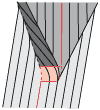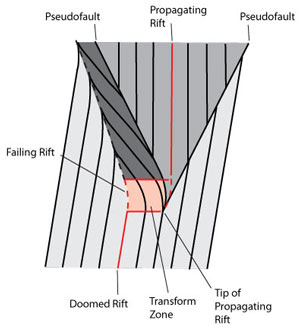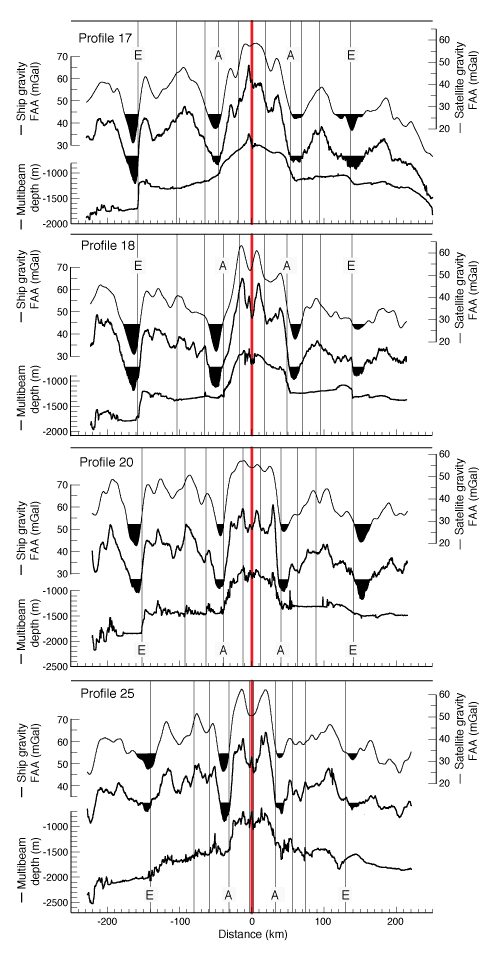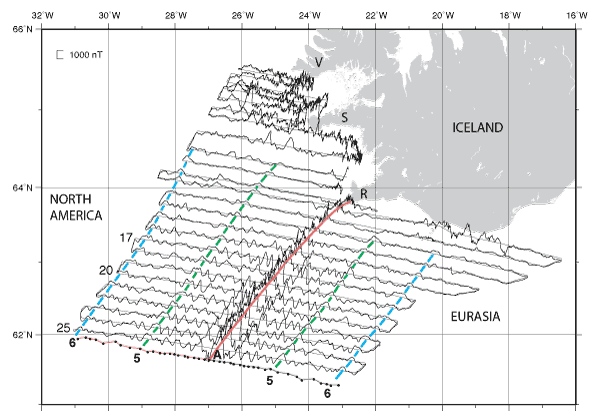 |
The
pulsing Iceland plume: A personal
evolution from believer to agnostic
|
Richard Hey
Hawaii Institute
of Geophysics and Planetology, School of Ocean and
Earth Science and Technology, University of Hawaii,
Honolulu, HI 96822 USA, hey@soest.hawaii.edu
Full disclosure
Jason Morgan was my Ph.D. advisor
when he proposed his mantle plume model and resurrected
Tuzo Wilson’s
hotspot hypothesis, which at the time was not generally
accepted. The South Africans, for example, were convinced
that the Walvis aseismic ridge could not be a hotspot
track, groups at both Scripps and Oregon State insisted
that non-hotspot models were required for the Galapagos
area, and at the time no-one in Hawaii thought Hawaii
was a hotspot. All of us at Princeton thought Jason
was right of course – his track record
was pretty incredible, beginning with discovering plate
tectonics as a post-doc a few years earlier.
Assuming Jason was always right was
a very good career move for me. My dissertation work
showed how the seemingly fatal geometric arguments
against the Cocos and Carnegie aseismic ridges being
Galapagos hotspot tracks could be resolved, the key
being ridge axis jumps toward the hotspot. This seemed
like a plausible effect of a hotspot/plume, and I grew
up thinking these concepts were correct. Fresh from
this triumph for the embattled hotspot hypothesis,
I gave a recruiting talk at the University of Hawaii
that began “Good news. Despite
what you’ve been led to believe Galapagos is
a hotspot just like Hawaii”, and the entire faculty
rose up enthusiastically and said “Hawaii’s
not a hotspot”, so I had to quickly prepare a second,
more introductory talk. The controversy used to go
the other way.
I assumed Iceland was a hotspot too,
presumably overlying some kind of deep mantle convection
plume, and in addition, Peter Vogt had shown it was
a pulsing plume when he discovered the V-shaped basement
ridges and scarps, commonly called VSRs, symmetrical
about the Reykjanes Ridge south of Iceland (Vogt,
1971). He proposed that pulses of asthenosphere flowing
away from an Icelandic plume would combine with seafloor
spreading to produce the diachronous VSRs.
His model was so simple and elegant
I thought it had to be correct. The VSRs proved that
something in the plume-ridge system was variable, and
if it wasn’t
the ridge, which was known to be spreading symmetrically
in a stable (although oblique) geometry, it must be
the plume. The logic seemed inescapable. Thus when
Gillian Foulger, Don Anderson, and their colleagues
proposed their alternative model for the Iceland melt
anomaly, a broad zone of unusually fertile upper mantle
(Ed: see Iceland & the
North Atlantic Igneous Province)
(Foulger & Anderson,
2005),
I thought it was demonstrably wrong, because a broad
upper mantle heterogeneity would not pulse, and so
could not produce the VSRs. I noticed their group never
discussed this, and thought it was a fundamental problem
for their model (Ed: I agree, it was, which is why
we never discussed it). So when I was asked to review
Gillian’s
anti-plume book proposal (Ed: see Plates
vs Plumes: A Geological Controversy) I declined
because I thought I was too biased in favor of plumes
to be objective.
I was aware that propagating rifts
(PRs) also produce V-shaped wakes, but these must be
asymmetric, in contrast to Vogt-type wakes. PRs reorganize
seafloor spreading geometry by breaking through existing
lithosphere and transferring some from one plate to
the other, resulting in “too much” lithosphere
on the failed rift side and “too little” on
the other, so in addition to asymmetric pseudofault/failed
rift wakes, asymmetric seafloor spreading is another
predictable consequence of rift propagation (Figure
1; Hey et al., 1989). Thus for the PR model to work
south of Iceland, all of the conventional wisdom about
the Reykjanes Ridge that was entirely consistent with
pulsing plume models, that the VSRs were symmetric
about the ridge axis and that seafloor spreading was
also symmetric, would have to be wrong. This did not
seem possible.

Figure 1: ldealised oceanic propagator
system. Mid gray: crust formed at propagating rift,
light gray: crust formed at dying rift, dark gray:
lithosphere transferred from one plate to the other.
Everyone knew the Reykjanes Ridge was spreading symmetrically
because Fred Vine (and Ellen Herron, another excellent
magnetic anomaly analyst, or “wiggle picker”,
as we were known) had said so, and I knew Fred was
never wrong. His iconic color figure of the classic
Heirtzler et al. (1966) Reykjanes Ridge aeromagnetic
data correlated with the magnetic reversal timescale
was one of the most important demonstrations of the
magnetic symmetry predicted by seafloor spreading,
at the time still a highly controversial hypothesis.
However, Fred hadn’t tested
the symmetry statistically, as he admitted (to appreciative
laughter) in response to a question at the influential
1966 conference on the History of the Earth’s
Crust at the Goddard Institute for Space Studies in
New York, where he presented his figure. "I never touch
statistics. I just deal with the facts," he
said. Fred was trying to have a scientific revolution,
and of course on that scale pretty symmetric seafloor
spreading is a reality. However, on a finer scale asymmetric
spreading can be seen in his figure (Vine, 1968) now
that you know it’s
there.
Everyone knew the VSRs were symmetric
about the Reykjanes Ridge axis because Peter Vogt (and
many others) had said so, and I knew Peter is also
an outstanding scientist, considerably ahead of his
time in discovering the VSRs in the classic Talwani
et al. (1971) single-channel
data. However, these data were collected before plate
tectonics defined seafloor spreading flowlines, so
Talwani et al. (1971) did what any of us would
have done in 1966 and ran their tracks perpendicular
to structure. It later turned out that the Reykjanes
Ridge was spreading obliquely. Thus the supposedly
conjugate structures Vogt originally identified on
these profiles as symmetric must necessarily have been
formed at different times and places on the axis, and
so couldn’t
actually be symmetric conjugate features if his model
was correct. This important point was first made by
Johansen et al. (1984) in an unfortunately
widely ignored paper.
Recent work
Working on the assumption that in
trying to understand this type-example of hotspot/ridge
interaction it couldn’t hurt to understand the
ridge evolution better, Fernando Martinez, Ármann
Höskuldsson,
and I led a marine geophysical expedition on the R/V
Knorr in the summer of 2007, with tracks along spreading
flowlines to avoid the complications Vogt faced. All
existing pulsing plume models (and even the innovative
alternative model of Hardarson
et al. (1997), which
helped stimulate our thinking about the area) predicted
the VSRs should be symmetric on these tracks, whereas
the PR model required them to be asymmetric. Our results
were recently published in G3 (Hey
et al.,
2010).
As it turns out, the conventional
wisdom was wrong, and the pulsing plume model that
most of us grew up thinking was obviously correct was
based on the incorrect assumption that the VSRs are
symmetric about a stable, symmetrically-spreading Reykjanes
Ridge axis. We have shown that this assumption is not
true. The VSRs are not symmetric about the axis, and
seafloor spreading has not been symmetric about a stable
axis. This asymmetry is smaller where Vine and Vogt
worked, south of 62°N, but increases toward Iceland,
where we had the great advantage of working. For example,
where Vogt’s E scarps intersect our track 17
just south of the Iceland shelf (Figure 2), they are
20 km farther from the axis on the North American plate
than on the Eurasian plate. Vogt’s A scarps
are asymmetric in the opposite sense, farther from
the axis on the Eurasian plate, so no single axis can
make both scarps simultaneously symmetric. The conjugate
features must have formed contemporaneously at a ridge
axis, yet today there is ~30 km more lithosphere on
the North American plate than on the Eurasian plate
between the A and E troughs and scarps.

Figure 2. VSR asymmetry shown by
profiles of satellite (top) and shipboard (middle)
free air gravity anomalies and bathymetry (bottom).
Note the asymmetry of Vogt’s
E scarps (farther from the axis (red) on the North
American plate) and A scarps (farther from the axis
on the Eurasian plate), although on each profile
equivalent scarps are equal ages because of the proposed
ridge jumps (vertical lines). The gravity troughs
(shaded) at the bases of the A and E scarps are always
wider apart on the North
American plate than the Eurasian plate, demonstrating
VSR asymmetry independent of the exact location of
the present ridge axis. From Hey
et al. (2010).
Similarly, on track 17 anomaly 6 is ~25 km farther
from the axis on North America than it is on Eurasia,
and anomaly 5 asymmetry is evident near Iceland (Figure
3).

Figure 3: New marine magnetic anomaly
data which demonstrate asymmetric seafloor spreading.
Anomalies 5 (green dashes) and 6 (blue dashes) are
always farther from the ridge axis (A, red line)
on North America than Eurasia. The spacing between
anomalies 5 and 6 is also consistently (~10 km) greater
on the North American plate than on the Eurasian
plate, demonstrating seafloor spreading asymmetry
independent of the exact location of the present
ridge axis. From Hey
et al. (2010).
These asymmetries are inconsistent
with all previous models, but rift propagation creates
such asymmetries, and also produces V-shaped wakes
that in other areas show crustal thickness variations
similar to those proposed for these VSRs. This suggests
a possible tectonic alternative to magmatic explanations
such as the pulsing plume models. We suspect that many
studies that have concluded they were consistent with
a pulsing plume could also be consistent with our new
model.
As a result, I am now agnostic on
the subject of an Iceland plume. A pulsing plume (or
even a plume) is not required for rift propagation,
although if plume pulses do exist they would certainly
provide a plausible driving mechanism for propagators.
At this point I think it is fair to say that the Reykjanes
VSRs can no longer be used as proof that Iceland is
a pulsing plume, and that a fair question for pulsing
plume proponents is, if you did not already “know” Iceland
was a pulsing plume, would your own data be compelling
that it is one? And probably of greatest interest to
this website, if Iceland cannot be shown to be a pulsing
plume, would your data still convince you it is definitely
a plume, as opposed to, for example, the fertility
model of Foulger, Anderson and their colleagues?
References
-
-
Hardarson, B.S., J.G. Fitton,
R.M. Ellam, and M.S. Pringle, Rift relocation-A
geochemical and geochronological investigation
of a palaeo-rift in northwest Iceland, Earth
Planet. Sci. Lett., 153,
181-196, doi:10.1016/S0012-821X(97)00145-3, 1997.
-
Heirtzler, J.R., X. Le Pichon,
and J.G. Baron, Magnetic anomalies over
the Reykjanes Ridge, Deep
Sea Res., 13, 427–443, 1966.
-
Hey, R.N., J.M. Sinton, and
F.K. Duennebier, Propagating rifts and
spreading centers, in The Eastern Pacific Ocean
and Hawaii, The Geol. of North Am., vol. N, pp.
161–176, Geol. Soc.
of Am., Boulder, Colorado, 1989.
-
Hey,
R., F. Martinez, Á.
Höskuldsson,
and Á. Benediktsdóttir, Propagating
rift model for the V-shaped ridges south of Iceland, Geochem.
Geophys. Geosyst., 11,
Q03011, doi:10.1029/2009GC002865), 2010.
-
Johansen, B., P.R. Vogt, and
O. Eldhom, Reykjanes Ridge: Further analysis of
crustal subsidence and time-transgressive basement
topography, Earth
Planet. Sci. Lett., 68, 249-258,
doi:10.1016/0012-821X(84)90157-2, 1984.
-
Talwani, M., C.W. Windisch,
and M.G. Langseth Jr., Reykjanes Ridge
crest: A detailed geophysical study, J.
Geophys. Res., 76, 473–517,
doi:10.1029/JB076i002p00473, 1971.
-
Vine, F.J., Magnetic
anomalies associated with midocean ridges, in The
History of the Earth’s
Crust, edited by R.A. Phinney, pp. 73–89,
Princeton Univ. Press, Princeton, N. J., 1968.
-
Vogt, P.R., Asthenosphere
motion recorded by the ocean floor south of Iceland,
Earth Planet. Sci. Lett., 13,
153–160, doi:10.1016/0012-821X(71)90118-X,
1971.
last updated 3rd
June, 2010 |
